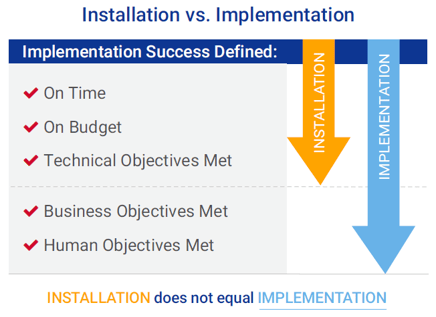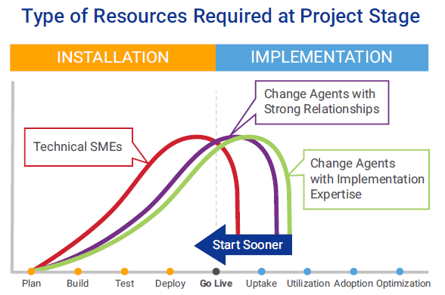Don Harrison, developer of the Accelerating Implementation Methodology (AIM), has dedicated his entire, distinguished career to helping organizations worldwide implement complex changes at speed. Several years ago, he began to notice an alarming trend. Organizations were so focused on getting to launch or “go live” of their initiatives, once they got there, they declared the project over. They checked the box that the project was complete and then moved on to the next. 
What these organizations didn’t understand is that while getting to launch is certainly a must-do, it is not enough. The truth of the matter is there is no change unless people change their behavior. When a project’s endpoint is declared at the point of cutover (what we like to call premature completion) it is often missing the key resources necessary to get to sustained behavior change and ultimately Return on Investment. It may look like change, but it’s change only at the surface level. Don began calling this phenomenon the difference between Installation vs. Implementation.
Defining Installation vs. Implementation
Installation is when a project is on time, on budget and the technical objectives have been met. In other words, it has been launched. To get to full Implementation, there are two additional success metrics that must be achieved. Both the business objectives and the human objectives must also have been met.
 The human objectives are the behaviors you seek to see in the future. In other words, what will all the people who are impacted by the change be doing differently in the future?
The human objectives are the behaviors you seek to see in the future. In other words, what will all the people who are impacted by the change be doing differently in the future?
The High Price of an Installation Mentality
At a time when there is more need than ever before to extract maximum value from every initiative, far too many are sub-optimized because they have fallen into the Installation trap. While millions of dollars are being invested annually into business changes, from new technology to shared services, process improvement and new patient care models, the majority never reach full value realization. Recent research (as well as our own) supports this notion:
- The PMI 2016 Research Report found that for every $1 Billion invested, $122 Million is wasted due to poor project performance, which is a 12% increase over 2015
- Innotas quotes 55% of businesses surveyed reported an IT project failure in the year 2015
- In September of 2016, The Standish Group reported fewer than 1/3 of all projects were successfully completed on time and on budget over the year
Yet despite the data, organizations continue to put much more emphasis on the achievement of technical and even business objectives than on the human and cultural elements of changes.
Resource Allocation
In a world where resource scarcity is an on-going reality, we cannot afford to create separate technical project plans and human side project plans that we loosely bolt together as an afterthought, or struggle to deploy in parallel. 
Instead, both the technical side and human side of Implementation must be managed concurrently to achieve real project success. In other words, the right people need to be deployed at the right stage of the project lifecycle.
For example, technical SME’s and Change Agents, both with strong relationships in the organization and Implementation expertise need to be involved early, during the Installation phase of the project. Starting sooner will help to ensure there is rigor and discipline on the people side at the same level and same time as the technical side of the initiative.
4 Steps to Move to an Implementation Mentality
To increase the likelihood of success, organizations need to change from an Installation mentality to an Implementation mindset {Tweet This}. Here are four actions that organizations can take to change the strategic goal from Installation to Implementation:
- Have a common Implementation Framework (such as AIM) and vocabulary that are universally shared across the organization.
- Require every project to have an “Implementation Plan” that includes at minimum a:
- Clear and Concise Definition of the Change
- Sponsorship Strategy
- Readiness Strategy
- Communication Plan
- Reinforcement Strategy - Ensure Sponsors and Agents have clear expectations for their respective roles, and then hold them accountable.
- Adjust the definition of “project success” so that a project isn’t deemed to be fully complete unless and until it gets to optimization.
Don't let your organization remain a victim of the Installation trap. Adopt an Implementation mindset from the start to ensure full benefit realization from every business change.
For more information about the difference between Installation and Implementation, download your free copy of IMA’s newly, revised Mini Guide to Installation vs. Implementation today!


